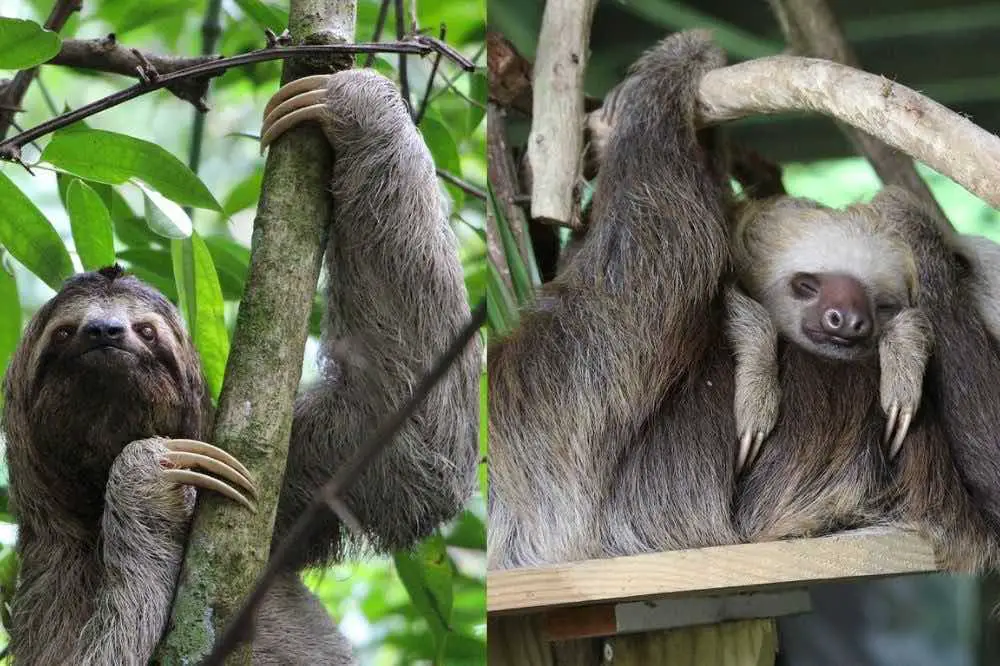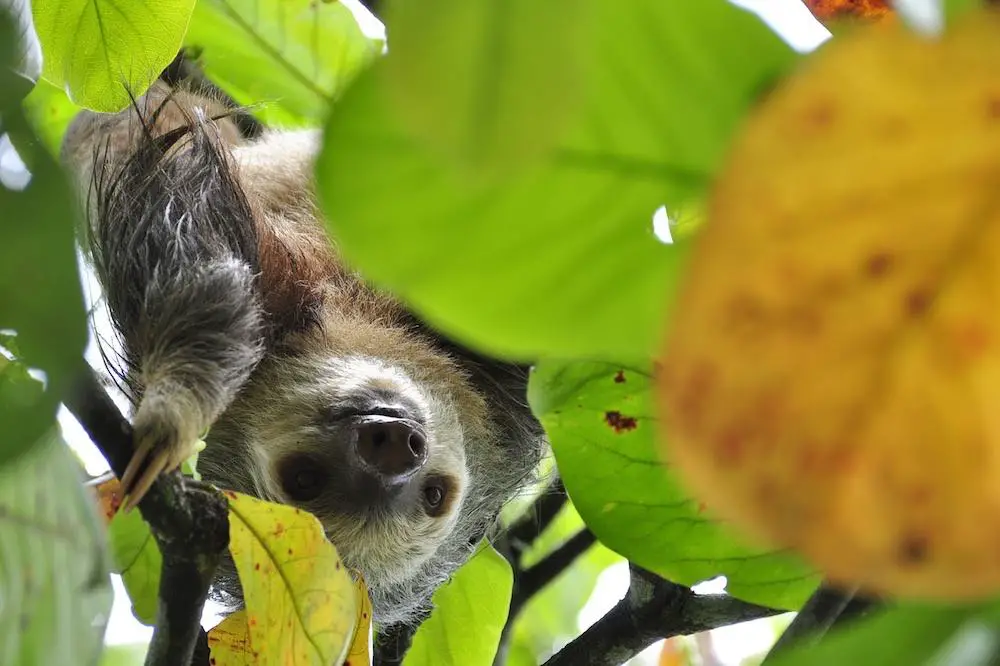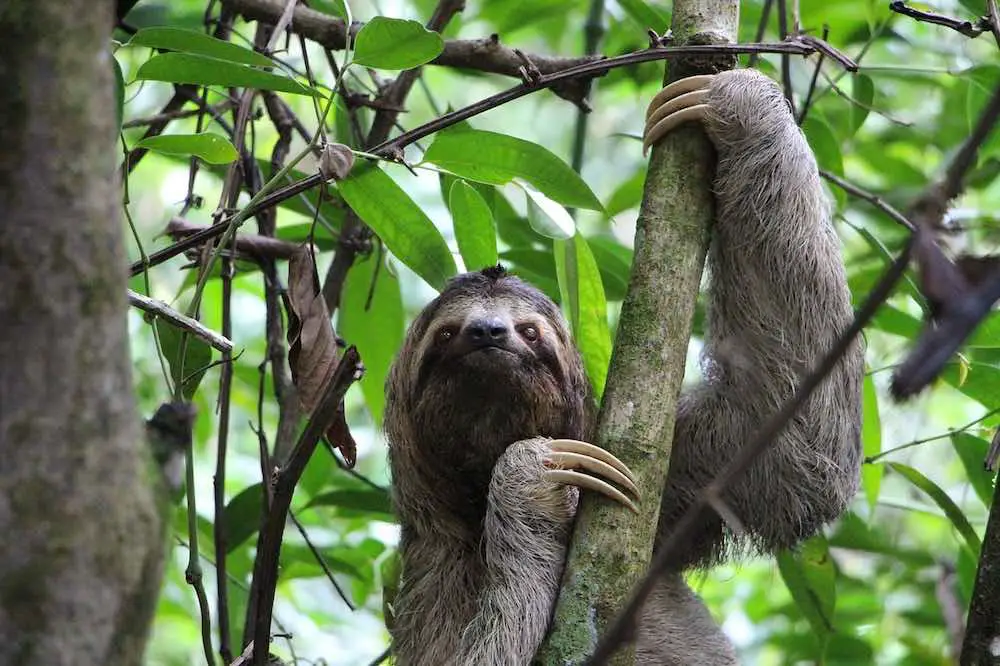
When I started reading up on sloths I had no idea there were so many different species. These are split up between two larger groups, with a number of species below this. So what is the difference between two-toed and three-toed sloths?
Before looking into them a little more, I couldn’t answer this question either, but now I know enough about these differences to be able to explain them fully.
So what is the difference between two-toed and three-toed sloths? The difference between two-toed and three-toed sloths is that two-toed sloths have 2 toes on their forelimbs, and three-toed sloths have 3. They are in different families and have a different amount of species. Two-toed sloths are bigger and have more ribs and three-toed sloths have more vertebrae.
There has to be more to it than this right? Well there is, and I’ve gone in to a lot more detail about this below.
You will see that two-toed and three-toed sloths have evolved entirely separately, but have ended up living in the same places, sharing the same behaviours. Read on to find out more about this!
Contents
What Is The Difference Between Two-Toed And Three-Toed Sloths?
When you talk about sloths to most people, there is a complete lack of understanding of the species as a whole. I can totally understand this.
In my early twenties I visited an animal sanctuary in Mexico. While I was there I was lucky enough to see a sloth up close, as sloths are not really dangerous to humans. Certainly not the one I saw anyway!
However, I have no idea which kind of sloth I actually saw. Due the fact that sloths tend to live in the same places, we assume they are all the same.
Sloths are native to the rainforests of South and Southeastern America. They spend all of their time living and eating in trees. In fact sloths can appear green as they are covered in algae that helps them stay camouflaged in these trees.
They can also help to protect the environment that they live in, and this gives sloths a very special relationship with the trees around them.
As you will see below, there are 6 different types of sloths, with a further 12 subspecies. Whilst there are 12 extant sloths (the opposite of extinct), there are a great number of extinct species of sloths too.
Sloths come from the superorder of Xenarthra, which is a group of placental mammals. There are a number of families within this superorder, and some of the other animals included in this are armadillos and anteaters.
The order underneath this superorder that sloths belong to is called Pilosa. Within this order there are two suborders. These are Folivora, of which the sloths belong to, and Vermilingua, of which anteaters belong to.
Do Two-Toed And Three-Toed Sloths Come From Different Families?
So the first difference between two-toed and three-toed sloths is actually the families that they belong to. When you have an understanding of this, you can begin to see why there are so many differences between two-toed and three-toed sloths.
If you trace the history and strucure of all of the different sloths, this carries down from the superorders and orders above into superfamilies, and then families.
Two-toed sloths belong to the superfamily Mylodontoidea, and within this superfamily sits three families. These are:
- Cholopodidae
- Mylodontidae
- Scelidotheriidae
The only extant sloths we have today are members of the Cholopodidae family, which we will look at in more detail below.
The three-toed sloths come from the superfamily Megatherioidea. This is split into four families, and these are:
- Bradypodidae
- Megalonychidae
- Megatheriidae
- Nothrotheriidae
The only extant sloths that come from the above list are members of the Bradypodidae family.
Which Species Belong To Two-Toed And Three-Toed Sloths?
Underneath the superfamilies and families listed above, comes the genus. The next difference between two-toed and three-toed sloths comes in the genus they belong to, and the different species of sloths that sit underneath this.

Two-toed sloths belong to a genus known as Choloepus. Within this genus Chloepus, there are two different types of two-toed sloths. These are:
- Linnaeus’s two-toed sloth (Choloepus didactylus)
- Hoffmann’s two-toed sloth (Choloepus hoffmanni)
The three-toed sloth comes from the genus Bradypus, underneath the family Bradypodidae. In contrast to the two-toed sloths, there are four extant members of this genus of sloths. These are:
- Pygmy three-toed sloth (Bradypus pygmaeus)
- Maned three-toed sloth (Bradypus torquatus
- Pale-throated three-toed sloth (Bradypus tridactylus)
- Brown-throated three-toed sloth (Bradypus variegatus)
How Many Subspecies Of Two-Toed And Three-Toed Sloths Are There?
Another difference between two-toed and three-toed sloths comes in the form of subspecies of these animals. Like I said at the start, most people don’t even realise there are different types of sloths.
I was in fact surprised to learn not only are there two different families, and then a further six species. Even more surprising is the fact that there are 12 subspecies of sloths as well.
Whereas two-toed sloths have a further five subspecies, three-toed sloths have seven.
So as I said above, the genus Choloepus is split into the Linnaeus’s two-toed sloth and the Hoffmann’s two-toed sloth. Underneath this, the Hoffmann’s two-toed sloth can be split into a further five subspecies. These are:
- Choloepus hoffmanni hoffmanni
- Choloepus hoffmanni agustinus
- Choloepus hoffmanni capitalis
- Choloepus hoffmanni juruanus
- Choloepus hoffmanni pallescens
The genus Bradypus can be split into a further seven subspecies of sloths. It is only the Brown-throated sloth from this genus that has subspecies. Thera are seven of these in total, and these are:
- Bradypus variegatus boliviensis
- Bradypus variegatus brasiliensis
- Bradypus variegatus ephippiger
- Bradypus variegatus gorgon
- Bradypus variegatus infuscatus
- Bradypus variegatus trivittatus
- Bradypus variegatus variegatus
So another major difference between two-toed and three-toed sloths comes in the amount of subspecies within the genera that they belong to. Three-toed sloths have five subspecies, whereas three-toed sloths have seven subspecies.
Do Two-Toed And Three Toed Sloths Really Only Have This Amount Of Toes?
No discussion about the difference between two-toed and three-toed sloths would be complete without talking about their toes. I mean it’s in their name, so it must be one of the major differences right?
Now the name in some ways can be a little misleading. The reason I say this is because both two-toed and three-toed sloths have three toes on their hind limbs. It is only on their forelimbs where this differs.

The difference between the two genera of sloths is that the two-toed sloths have two toes on their front limbs or arms, whereas the three-toed sloths have three. While this seems like quite a subtle difference between these two sloth types, it does point towards the bigger differences in terms of their families.
Two-toed and three-toed sloths, although both belonging in the superorder Pilosa, are not closely related. Two-toed sloths are more closely related to the extinct sloths known as ‘ground sloths’.
While both two-toed and three-toed sloths have developed into quite similar animals in terms of appearance and behaviours, this is an example of convergent evolution.
What this means is that over a very long period of time, two or more species have adapted to their surroundings to become similar in appearance and or behaviours. Both types of sloths have adapted to the rainforest over a long period of time, and as such share many of the same traits.
Two-Toed And Three-Toed Sloths – Which is Bigger?
In looking at the difference between two-toed and three-toed sloths, you can generalise to say that one is bigger than the other as a species. In general the two-toed sloth species tends to be bigger in size and weight than the three-toed sloths.

This would tie in with two-toed sloths being more closely related to the extinct ground sloths. These were much bigger in size and much heavier too.
Certainly in the three-toed sloth family, females grow to be both larger and heavier than their male counterparts. The smallest of the three-toed sloths is the pygmy sloth, which has a head and body length between 48 and 53 cm (19 to 21 inches).
In contrast, the Hoffmann’s two-toed sloth can grow from 54 to 72cm (21 to 28 inches) in head to body length. The other three-toed sloths are much bigger than the pygmy sloth, but they still tend not to be as big as the two-toed sloths.
Do Two-Toed And Three-Toed Sloths Have A Different Amount Of Vertebrae?
I had absolutely no idea about this difference between two-toed and three-toed sloths until I started reading up on them a bit more. For some, the amount of vertebrae they possess can ultimately help the sloths to protect themselves from predators.

Almost all mammals that exist today have the same amount of cervical vertebrae. The only mammals we know of that do not are the sloth and the manatee.
Two-toed sloths have less than normal, only possessing five of these cervical vertebrae. In contrast to this, three-toed sloths have up to nine of these cervical vertebrae.
What this means for this type of sloth is that they can turn their heads up to 270 degrees. I guess when you see cartoon sloths doing this, it’s because it is entirely possible, and not just an exaggeration on the part of the animator.
Being able to turn their heads so far round allows sloths to spot predators as soon as possible. So another major difference between two-toed and three-toed sloths lies in the amount of vertebrae they have, and how far around they can turn their heads.
This also helps three-toed sloths when they are swimming. They can easily hold their heads above the water due to this flexible neck. A pretty clever design feature of this type of sloth!
Why Do Two-Toed And Three-Toed Sloths Have Different Lengths Of Arms?
Another crazy difference between two-toed and three-toed sloths lies in their lim proportions. There are so many different things that you just would not know about sloths unless you did some research on them.
Whilst two-toed sloths have arms and legs that are roughly the same length, three-toed sloths do not. Their front limbs, or arms, are quite a bit longer than their hind limbs or legs. This makes it even harder for a three-toed sloth to walk. They have to effectively drag their legs behind them, or shuffle on their bums with them in front.
If you think about this difference, and what I said above about two-toed sloths being closely related to ground sloths, it makes perfect sense. Two-toed sloths have evolved to live in trees, where they were once more at home hundreds of years ago living on the ground.
Do Two-Toed And Three-Toed Sloths Have A Different Number Of Ribs?
From the outside, sloths look fairly similar across the board. Sure some have longer fur, and the fur can be colored differently. You can be forgiven for not being able to distinguish them from each other.
However, some of the more interesting differences between these types of sloths comes internally. We just saw above that two-toed and three-toed sloths totally break away from the norm by having a different amount of vertebra than almost any other mammal on the planet.
The same can be said when it comes to the amount of ribs these two different types of sloths have. The three-toed sloth has 28 ribs, while the two-toed sloth has 46 ribs.
This is a huge variance, and again points to the idea of convergent evolution. They are both very different as a species, and yet have evolved to live in the same places and largely behave in the same ways.
Do Two-Toed and Three-Toed Sloths Eat Different Things?
It sound crazy to suggest that diet can be a difference between two-toed and three-toed sloths. We know that all sloths live in trees, and they survive almost entirely on the leaves of these trees. Both species will choose to eat younger leaves as these are easier to chew and digest.
There is a subtle difference between the two species though. Three-toed sloths are entirely herbivorous. This means that they will only eat the leaves from the trees that they live in.
Two-toed sloths are actually slightly different, in that they are omnivorous. This means that as well as eating leaves, and some flowers and berries, they will also eat a number of different insects too.
Summing Up
Who knew there was so much difference between two-toed and three-toed sloths? From the families, species and subspecies to differences such as how many vertebrae and ribs they have.
Each of the differences serves to remind us that both of these species of sloths evolved from different ancestors, but through a process of divergent evolution, ended up with a whole host of similarities too.
I hope you found the information in this post interesting and useful. If you have anything to add, or would like to ask a question, then please leave a comment below.
